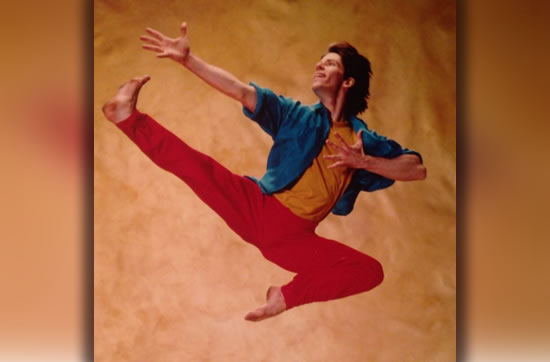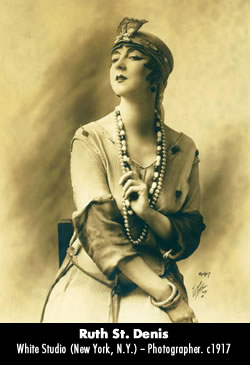Isadora and St. Ruth: Birth Mothers of American Modern Dance
By Kenneth Topping

Kenneth Topping
Isadora Duncan (1878-1927) will forever be known for standing up to 500 years of classical ballet dominance, instigating a dance revolution in America and around the world. The first of the modern dance rebels, she discovered a primordial grace linked to the classicism of Greece. Becoming a symbol of freedom not only for dancers but for all Americans fighting the status quo in the midst of the Progressive Era (1890-1920), Isadora spoke out on issues like women suffrage, education reform, unionization, and child labor reform. She opposed the society of the time – one that she viewed as a caste, shaped by unchecked capitalism and governed by the philosophy of materialism. Pushing against the Puritan and Victorian moralities saturating American life, she chose to reveal the hitherto hidden female body, instead celebrating the sensuous and the sensual as symbols of the “spiritual”. Speaking after performances on issues of social injustice, especially the plight of the poor, Isadora opposed the pervasive urge to accumulate stuff, encouraging, instead, the worship of Beauty and Nature. She danced in a flowing tunic to the music of great composers, revealing the invisible human soul that she said exists in all of us. Her identification with Greece and its great achievements in art and culture, it's understanding of the human spirit, elevated Isadora's art and offered her the perfect vehicle to express beauty, nature, and liberty. Like dancing Greek figurines come to life, Isadora danced barefoot with her aspiring students, the “Isadorables”, infusing beauty into life. She believed that if “the body were made light, graceful, and free in movement, it would, to a great extent, influence people's consciousness and social lives”. Recognizing her dance style as groundbreaking, the public severed the connection between her dance and entertainment, identifying it as “high art”, alongside classical ballet. The California-born dancer of Irish descent declared she was born “a dancer and a revolutionist”. In the midst of social, political, and artistic upheaval, Isadora Duncan thrived, declaring this century the one in which the “dancer of the future” would be born.
 Her revolution was just getting started when she died tragically at the young age of forty-nine. The trail of freedom Isadora blazed lit the way for Ruth St. Denis, a New Jersey girl, who would become known as “the first lady of American Dance”. Continuing the fight for hearts and minds, Ruth, with Ted Shawn (more on him later), would open the first American school of dance to train the “dancers of the future”: the modern dance pioneers. They would go on to create new dance techniques, new approaches to choreography, and new concepts for dance theater. But before getting too far ahead of ourselves, let's take a look at “the first lady of American Dance”, Ruth St. Denis, whose passion for dance was awakened, believe it or not, by an ad for cigarettes.
Her revolution was just getting started when she died tragically at the young age of forty-nine. The trail of freedom Isadora blazed lit the way for Ruth St. Denis, a New Jersey girl, who would become known as “the first lady of American Dance”. Continuing the fight for hearts and minds, Ruth, with Ted Shawn (more on him later), would open the first American school of dance to train the “dancers of the future”: the modern dance pioneers. They would go on to create new dance techniques, new approaches to choreography, and new concepts for dance theater. But before getting too far ahead of ourselves, let's take a look at “the first lady of American Dance”, Ruth St. Denis, whose passion for dance was awakened, believe it or not, by an ad for cigarettes.
In 1905, as Isadora opened her first of many dance schools in Europe (Germany), Ruth St. Denis was touring as an actress with the David Belasco Theater Company. While on tour in Buffalo, she walked into a drugstore and sat down at the soda counter. Across from her hung a poster, a cigarette advertisement depicting the image of a mysterious goddess. “It struck me like a blow”, she said. The goddess Isis perched on her throne, framed by majestic temple columns, looked up to the heavens, her eyes seeming to question and answer simultaneously. The deity “sat there starring out into the eternities [giving me] the opposite stillness to the tremendous energy that was going on as a girl all the time”, she said. Another person seeing this ad for “Egyptian Deities” cigarettes may have purchased a pack, but the artist, Ruth, bought the poster. This marked the beginning of a lifelong passion for Eastern religions, their rituals, and their gods. She began searching city libraries and museums for facts and artifacts. While still working as an actress with Belasco, Ruth began choreographing a solo based on the goddess Isis from the poster. One solo lead to the next, and the next, and so on, until she had a collection of “oriental solos”, as she called them.
Like many other dance artists in the early 1900's, Ruth got her first dance break with Vaudeville before working as an actress with Belasco. With the help of her ever-encouraging mother, she landed a job in a new show as a “skirt dancer. Ruth said “I would never have had a career in dance if not for my mother. I owe it all to her”. Figuring prominently throughout her life (and as protective as Gypsy's Mama Rose was of her daughter, June), Ruth's mother drove her from their farm house in Newark, New Jersey to The Big Apple to join a line of young hopefuls waiting their turn to audition for a spot in a new Vaudeville production. Her mother would have gleefully bellowed out “You gotta get a gimmick...if you wanna be a star”, but Sondheim's lyrics had not yet been dreamt of. Instead, Mrs. Dennis proudly declared to the other girls, and to the casting director, that her 16 year old daughter's extraordinary “slow kicks” (high kick with slow descent) would be her golden ticket to Vaudeville. And like Mama Rose, she was right. Under mother Dennis's watchful eye, Ruth performed five shows a day, six days a week, for $25.00. Directors and audience members took note of Ruth's captivating stage presence as she instinctively combined acting with movement and movement with acting. The attention and praise built her confidence as a performer, but it didn't take long for her to grow weary of showing off her “slow kicks” week after week. That's when she left Vaudeville to join Belasco, touring, as she said emphatically, “not as a dancer, but as an actress”.
Like Isadora's dances, Ruth embraced feminine sensuality as transcendent, reaching for the lofty heights of Hindu gods and goddesses. With her collection of dances, she performed at the same salons of society ladies who provided Isadora with an escape from the commercialism that she so detested. Unlike Isadora, however, whose inspiration often came from music, Ruth chose specific landscapes, specific characters, and specific ideas, for her choreography. She became a persona on stage in the same way an actor transforms into the character of a play.
In the beginning, Ruth's naive American perspective of the East, perhaps due to her lack of firsthand exposure to these far off places, made her interpretations less than culturally accurate, but this did not detract from the discoveries she made in the power of ritual and the holiness of the sacred. Her ability to duplicate the quiet power of Radha, for example, mesmerized her admiring public. In 1906 Ruth followed Isadora's lead, embarking on a European tour where her ideas were embraced by poets, sculptures, writers, artists, and dancers. After three years of performing, choreographing, and collaborating with other artists, she returned to America where she toured the entire country. Her success was unprecedented. Even Isadora's popularity did not reach this level in America, finding her great success in Europe and Russia. Critics praised Ruth's artistry while audiences cheered for more. Crossing the continent, opening people's minds and hearts, Ruth nurtured a new audience for the modern dance pioneers soon to follow. All that she learned as a performer she imparted to her students who would enroll in The Denishawn School in Los Angeles, the first dance school in America to offer techniques and dance styles from every corner of the world. It became a remarkable laboratory of experimentation, producing the “dancers of the future” who would create their own dances and their own techniques.
Isadora Duncan dreamt of a Utopia in which “dance” illuminated the consciousness of children and adults, helping them find value beyond what is visible, discovering things felt by the human heart. She returned dance to its natural, primordial form of free expression. Isadora opened a door to a new world and Ruth St. Denis walked through. Ruth discovered the religions of the East with their power of ritual and their mystery of the sacred. Plunging into the wonders of Hinduism and Buddhism, Ruth reminded us that “Rhythm has been in religion for thousands of years. Dance was a gift to the gods. A salute to the gods”. Isadora's revolutionary urges and Ruth's passion for the sacred spirit profoundly impacted the development of the modern dance pioneers like Martha Graham and Doris Humphrey. For now, please join me in saluting the true birth mothers of American Modern Dance - Isadora Duncan and Ruth St. Denis.#
